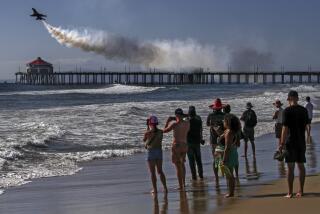Flying High Again
- Share via
In the air: roaring warplanes of every era and precision aerobatics by the U.S. Air Force Thunderbirds.
On the ground: ooohs and aaahs from thousands of spectators enjoying a rare visit to one of Ventura County’s most important yet most reclusive enclaves.
The Point Mugu Air Show is airborne again this weekend after being postponed last fall because of budget cuts and schedule conflicts.
It’s a special weekend for a couple of reasons:
First, the base throws open its guarded gates for two days and welcomes the public, to whom the U.S. Navy facility is normally off limits. In past years, as many as 200,000 visitors have come to see its sights and sounds.
Second, the air show is an uncharacteristically flashy affair for Point Mugu. The base’s mission of developing, testing and maintaining sophisticated weapons and radar systems is crucial to the nation’s defense--but rarely very sexy. That changes on air show weekend, when supersonic F-14 Tomcats and spooky-looking Stealth fighters swoop through the blue Pacific sky.
Much has changed since the base opened in 1946 as the first Naval Air Missile Test Center on the Pacific, both in the gear it tests and the threats it faces. Technological advances have brought the Navy from the wooden “Bat” glider missiles to today’s highly sophisticated electronic warfare systems and virtual-reality test chambers. At the same time, worries about Cold War attack have been replaced by a wary eye on Washington budget-cutters.
Under Congressional mandates to trim the nation’s defense budget, military bases have come under increasing scrutiny from Defense Department auditors to justify the money spent to maintain them. In 1994, Point Mugu came close to being shut down as the military scaled back from its Cold War peak. Although it was spared, the Point Mugu Naval Air Weapons Station and its sister base, the Port Hueneme Naval Construction Battalion Center, have experienced both losses and gains since then.
Earlier this year, the two bases agreed to cut costs by combining some departments, including public works, police, fire and recreation. The move will mean further downsizing, with mostly civilian workers losing jobs.
But in July the Navy expects to begin moving a squadron of 16 E-2C Hawkeye radar planes to Point Mugu from the San Diego area, bringing about 2,500 military personnel and family members to Ventura County.
The two Navy bases are important to Ventura County in many ways. Together they contribute nearly a billion dollars a year to the local economy. Their combined work force of more than 15,000 makes them the county’s largest employer. In addition, the Navy’s salty presence permeates the history and character of the cities of Port Hueneme and Oxnard.
County officials work constantly to reinforce the future of the bases, both by lobbying in Washington and by encouraging private-sector clients to use--and help pay for--the military facilities. At the same time, they are working to reduce the county’s economic reliance on the bases by helping local defense contractors find new markets for their goods and services.
For the most of the year, these efforts continue quietly. Air show weekend brings a dramatic reminder of the Navy’s key place in the unique mosaic of Ventura County.
More to Read
Sign up for The Wild
We’ll help you find the best places to hike, bike and run, as well as the perfect silent spots for meditation and yoga.
You may occasionally receive promotional content from the Los Angeles Times.






